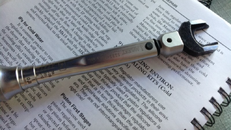Except he was futzing with it: specifically, rotating the regulator while under pressure (that was mentioned in a separate post, so you may not have noticed).
And here is a definite example of just such a thing happening on a properly torqued regulator, in a separate post he says this occurs when rotated on pressure.
I'm not saying you’re wrong. Just that you are jumping to conclusions, and exposing a bias.
I still contend that a properly torqued regulator, even if somewhat mishandled, should not loosen — though I don’t typically grab them by anything other than the tank valve; but I have occasionally done so in the past, while handling gear on boats, to no misfortune.
Yes, there‘s that account of a “properly torqued” regulator becoming loose, though likely mishandled in some way, not necessarily by the diver in question; but why haven’t I ever experienced that over decades and thousands of dives?
Ain't that lucky.
My job, as a kid, was disassembling regulators for the tech; washing the crap; and getting new gear up to specs, which occupied a good deal of my time. Some of the new gear arrived as loose as the OP described his first stage DIN connection, with fully loose blind screws rolling around in boxes, often set with IPs off the charts. All of the biggest brands were offenders.
Quality control was an issue then and now.
I challenge you to loosen a pressurized regulator, properly torqued to 30 nm — I can’t do that, and I am not a delicate little flower . . .




